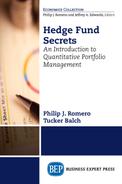There are many sources of stock price data. The following are a few illustrative feeds with which your authors are familiar:
These sources are described later.
Desirable Characteristics of Datafeeds
To be really useful, a source of price or information data should have the following characteristics:
• Historical as well as current data. Without historical price data, there will be no way to evaluate or backtest strategies.
• Free of survivor bias. The data should include stocks that died or were delisted, so as to avoid survivor bias, and permit testing of predictions of demise.
• Ease of integration and use. The data source should allow for easy export to the analytical engine or database the analyst uses. QSTK, for example, can export in .csv form, for use in Excel or most database programs.
• Low latency. Once trading strategies have been tested and evaluated, they will be used, which requires near real-time data. Efficient markets arbitrage away opportunities very quickly, so delays in receiving data aren’t acceptable.
Three Illustrative Information Feeds
These three are by no means the only candidates, just three with which your authors are familiar, focusing on those feeds that provide near real-time price data in addition to historic data.
• Thomson Reuters Machine Readable News: This feed delivers data with very low latency, in xml form (i.e., readily usable on other platforms). Its stories are tagged by stock symbol as positive, negative, or neutral, making it well suited to event studies.
• StarMine aggregates analysts’ estimates, weighting them by past accuracy. It predicts future changes in analysts’ sentiment, which the publishers claim can help predict future stock price movements. StarMine includes analysts’ revisions to their reports, and publishes a feed every evening.
• InsiderInsights tabulates and reports transactions by company insiders (typically board members and senior managers). Insiders are presumed to have superior information about a company’s position and prospects, so their buying or selling can be interpreted as pertinent information. Insider buying is usually construed as an unambiguous positive signal: Insiders generally buy only if they think the stock is a better investment than available alternatives. Selling by insiders need not be a negative signal, because insiders may sell simply because they have liquidity needs (college tuition, house down payment, divorce settlement, etc.) or because their portfolios are overweighted in company stock and they wish to diversify. (Financial planners argue that if your annual income derives from a company, it is foolish to allow your retirement to be equally dependent on that same company.)
Figure 14.1 shows the results of an illustrative event study conducted by Lucena Research using InsiderInsights data. There are two heavy lines:
The “Bin 0” line represents the average price of company stocks before and after an insider sale (at Day 0), with the succeeding fan showing the range of prices for different companies that experienced the event. The “Bin 1” line and fan represent insider buying. In the 21 days before the respective events, the average price fell by about 3 percent (after rebounding about 1 percent in the days immediately before the buying events). After the selling event, prices continue to modestly deteriorate, whereas they regained about 2 percent after the buying event, peaking about 15 days after the event.
Figure 14.1 Illustrative event study
Source: Courtesy Lucena Research, LLC and InsiderInsights.com.
These illustrate the range of data sources available, but are not meant as an endorsement.
Barton Biggs, Fairfield and Traxis Partners

Born: 1932; died 2012
Firm: Fairfield Partners, 1965 to 1973; Morgan Stanley, 1973 to 2003; Traxis Partners, Greenwich, CT, 2003 to 2012
Style: Global macro
Differentiation: SmartMoney called Biggs “the ultimate big-picture man . . . the premier prognosticator on the international scene and a mover of markets from Argentina to Hong Kong. It wouldn’t be a stretch to say Biggs wrote the book on emerging-market investing.” Voted the top global strategist and first in global asset allocation from 1996 to 2000 by Institutional Investor’s “Investor Global Research Team” poll. Named to II’s “All America Analyst Team” ten times.
Annual return: 11.2 percent (Fairfield Partners)
AUM: $1.5 billion (2005)
Biggs’ background: He grew up in Manhattan and majored in English at Yale under Robert Penn Warren. After college he worked as a stockbroker for E.F. Hutton before founding hedge fund Fairfield Partners in 1965. He joined Morgan Stanley as an analyst in 1973, becoming its global investing strategy head in 1985. He retired from Morgan Stanley in 2003 to found Traxis.
Color: Appropriate for a creative writing graduate, Biggs was a wry and literate writer, penning four best-selling books, the last (Diary of a Hedgehog) published posthumously in 2012. From its introduction: “The successful macro investor must be some magical mixture of an acute analyst, and investment scholar, a listener, a historian, and a riverboat gambler, and be a voracious reader. Reading is crucial.”

